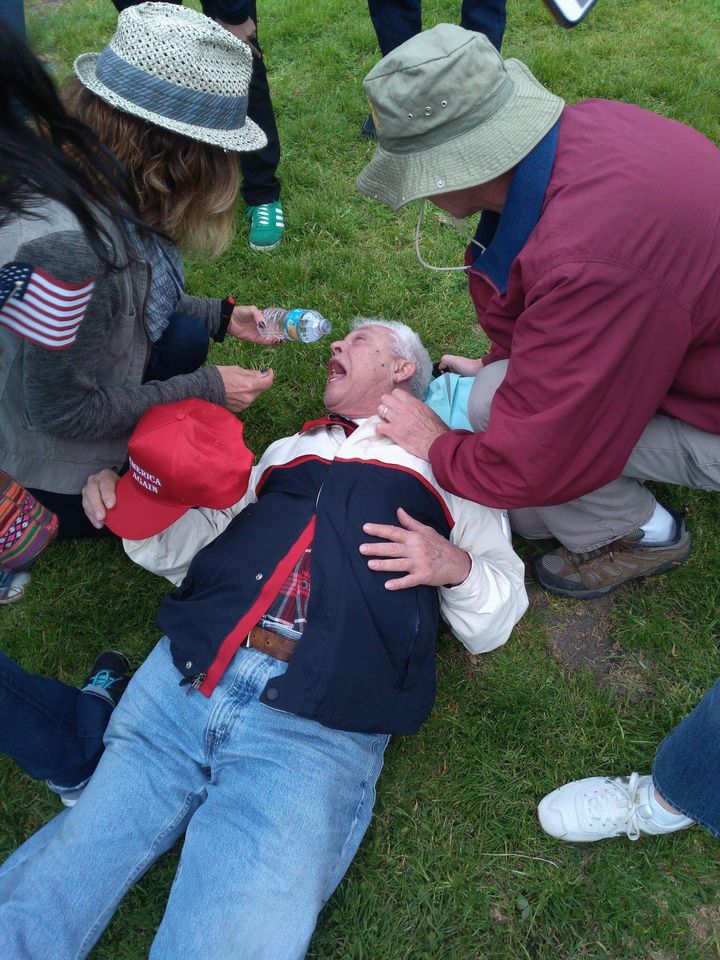The views expressed in this editorial are the views of Pranav Jandhyala and do not necessarily reflect BridgeCal as a whole
It’s interesting to me how simple political disagreements can quickly snowball into volatile spaces of violence and chaos, as we saw when Milo tried to speak at UC Berkeley. Or this weekend, when conservative organizers tried to hold a rally in support of President Trump in a park a couple blocks from UC Berkeley’s campus. It’s not just a social taboo to express certain political opinions anymore. It’s also becoming increasingly physically dangerous and even life threatening.
At the pro-Trump rally on Saturday, I watched as an old man holding a Trump sign was pepper-sprayed mercilessly. As he convulsed in pain on the ground, groups of radical leftist protesters cheered and laughed at him. The few supporters who rushed to him to provide medical attention were subsequently beaten with sticks. There was no shortage of bloodied, beaten faces and broken noses that day. And every attempt at self defense was met with more violence. It was truly a gruesome scene. And while all of this was happening, police in full riot gear stood just outside of the park, stoically watching as people were being attacked. As people ran to them pleading for them to get involved, they stood with no sense of urgency, as if they were completely oblivious to the brutality right in front of their visor shielded eyes. They never attempted to break apart the violent confrontations, even when they were at their very worst. There’s no excuse to watch on the sidelines as peaceful rally attendees are brutalized by large groups of people in plain daylight. There’s no riot protocol that calls for gross negligence.

Man being treated by fellow rally attendees after being pepper-sprayed
It’s deeply horrifying that in some places in this country, an act as simple as holding up a sign in support of our current President will be met with a face full of pepper-spray or a club to the top of the head. And it’s especially horrifying that there are so many in the radical left who will unconditionally support these responses.
I was curious about the driving psychology behind the hard left. So I decided to try and talk to some of them. I realized that while the violence was driven by anger and passions, some of the more peaceful counter-protesting left was driven by some rationality. When confronted about the violence, many, including members of groups like ANTIFA, denounced it. Though some tried to wage arguments in support of violence, most agreed that respectful political discussion between both sides on issues should be the model for how we have political conversations. This was an overwhelmingly universal sentiment that I recognized after talking to both Trump supporters and liberal counter protesters that day.
What I found interesting then was the discrepancy between what people seemed to really know and believe about violence as a response to political disagreements and consistent outcomes like physical assaults at protests. If everyone seemed to be in agreement about bipartisan political dialogue being the proper outlet, why weren’t the assaults preventable?
There was a pattern to what I observed many times that day: a leftist counter-protester would confront a Trump supporter about an issue like racism. But rather than waging a respectful and intellectual argument, they would simply call the Trump supporter a racist. Maybe they’d chant some words about racism along with the people around them. In response, the Trump supporter would yell back, and the whole thing would turn into a screaming match. Tensions would run high as people would start to circle around the argument. And in this period of high tensions, a radical leftist protestor would usually insert him or herself into the conflict and throw a punch, sparking a larger brawl. It was clear to me that when people started to engage in dialogue that was belligerently polemic and aimed at attacking others rather than dialogue that was centered, respectful, and solution-based, the outcome would almost always create a situation for violent passions to gain some footing.
The park that day was a stage for political conversations. I saw all kinds of conversations: the good, the bad, and the outright ugly. Most confrontations turned violent, but some remained entirely peaceful. Some people from both sides were even able to find some common ground. In a way, the park symbolized the state of our nation to me. While it revealed the terrible truth of the political divide and its consequences, it also revealed to me that there’s a space of possibility we can inhabit.
Things get better because we make them better. And we can be better. We can have better political conversations, better ways of dealing with our political differences. We can empathize with those who disagree with us. Sure, we are all individuals with widely different backgrounds, opinions, identities, and priorities. But we can reach a point where we are able to at least talk to each other without attempts at dialogue devolving into physical assault.
I witnessed one specific encounter in the middle of all the mess that really inspired me. An African American woman brought her young daughter to the event to counter-protest. They both held anti-bullying signs that raised concerns over Trump’s actions. The young African-American girl and her mother walked up to an older white couple holding pro-Trump signs. The young girl asked the older white woman a question about Trump and bullying, and the woman revealed she’d actually been working on an anti-bullying campaign at her local middle school for quite some time. They actually began a conversation about Trump, and afterwards, the older woman told the young girl to keep fighting for the causes she believed in, regardless of their different political beliefs.
To get to a point where our entire nation can empathize with the other side to this extent is a cause I believe we can all get behind. And it’s a cause we all need to keep fighting for.
